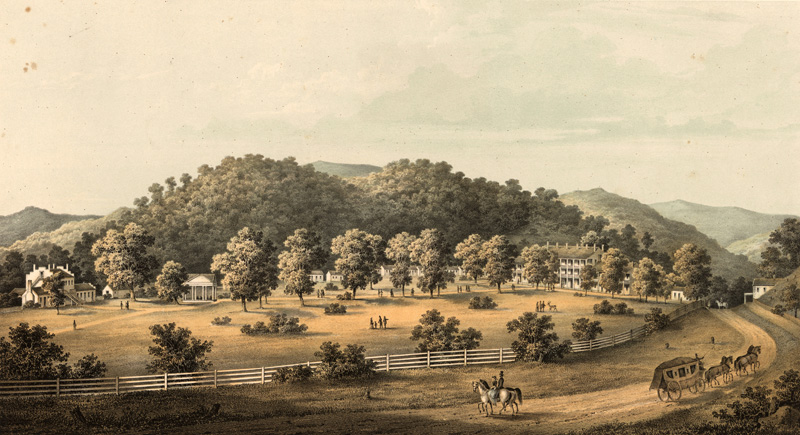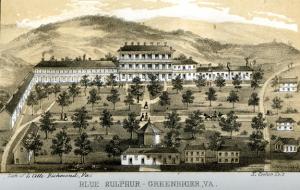Blue Sulphur Springs
Greenbrier County, West Virginia
The fountain is enclosed in marble slabs, is five feet in diameter, and one of the most beautiful objects imaginable. The sides are covered with a brilliant pink deposit, and the clear, cool, crystalline water seems to say, “Come and drink me.” William Burke

Edward Beyer’s print of Blue Sulphur Springs published in 1857. {1}
William Burke on the Blue Sulphur Springs.
Located in Greenbrier County in what is now West Virginia, Blue Sulphur Springs was in a valley with numerous improvements including a brick hotel with two additional buildings attached to make a continuous range of two and three story structures for 420 feet. By additional brick cottages and frame cabins Burke estimated in his 1846 book that 220 people could be comfortably accommodated. In fact, Burke described the style of living at Blue Sulphur as more elegant with nicer furniture and better service than that at any of the other springs except possibly Warm Springs and Salt Sulphur. The spring was in the center of the valley with a “well-designed but badly executed Temple” over it.

This lithograph drawn by E. Crehen clearly shows the long range of two and three stories. {2} The “Temple” over the spring is nearly 33 feet square and an example of Greek Revival architecture. It is the only remnant that remains as the other buildings were burned during the Civil War.
Burke appreciated the service, but deplored the arrangement of the buildings. He wrote, “Never have we seen bad taste more unfortunately illustrated than here. It seems as if the designer had his brain obfuscated by mint-julap. What man in his sober senses could have ever thought of spoiling a lovely valley like this, admitting a prospect of several miles, by throwing across it from hill to hill a long line of buildings which could have been so easily and so gracefully ranged along the sides; not only obstructing the view, but also preventing the delightful current of air which otherwise would have fanned it in the dog-days?” {Burke, 359} Dr. Martin was evidently the resident physician whom Burke held responsible for boilers built across the valley and suggested that he be consigned “to the care of Dr. Moorman, who might cause him to evolve gas in the stomach, for such an act of barbaric taste.”
Burke’s Recommendations for Using the Waters at Blue Sulphur Springs.
Dr. Burke wrote that the 53 degree Blue Sulphur water was pleasant to the palate but not as agreeable as either the White or Red Sulphur waters and not as advantageous as the same amount of the other sulphur spring waters. He suggested that dyspeptics begin with small amounts. Merit was claimed for “regulating certain periodical secretions.” Burke thought these claims were exaggerated but suggested the ladies try the waters and then judge for themselves. Due to the unsightly boilers, Dr. Martin could provide baths of any temperature which Burke pronounced useful if they were carefully administered.
Additional Information:
- National Register of Historic Places Registration Form: This detailed form for the Blue Sulphur Springs is dated September 23, 1992. It includes the history and significance of the springs, a description of the pavilion, a bibliography, maps, and a pavilion photo.
- The Greenbrier Historical Society: The Society now has title to the pavilion which has been identified as one of the most endangered historic resources in West Virginia and is working to restore it.
- National Register of Historic Places: The National Register has a brief summary of places in Greenbrier County, West Virginia.
- Photos of the Pavilion: Photos taken of the pavilion on Mary 26, 2006 are posted.
Image Credits:
- {1} Merritt T. Cooke Memorial Virginia Print Collection, 1857-1907, Accession #9408, Special Collections, University of Virginia Library.
- {2} John J. Moorman, The Virginia Springs of the South and West, Philadelphia: J. B. Lippincott, 1859: facing page 217. Historical Collections & Services, Claude Moore Health Sciences Library, University of Virginia.
Source:
- William Burke, The Mineral Springs of Western Virginia, New York: Wiley and Putnam, 1846.